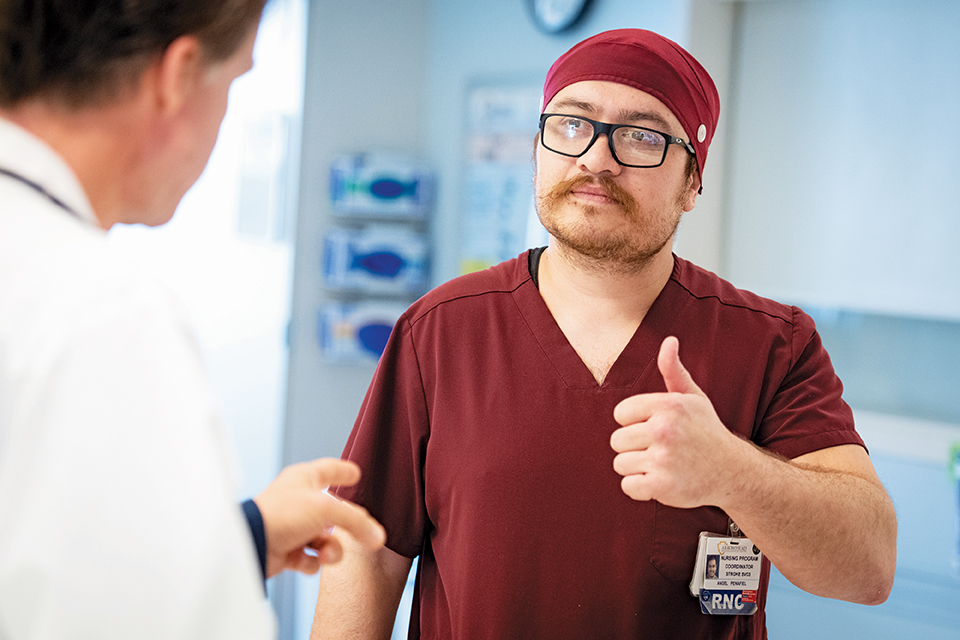My Specialty
Stroke Program Coordinator, Angel Peñafiel, ARMC
Providing both clinical care and administrative oversight for stroke patients

Angel Peñafiel, RN, BSN, CCRN, SCRN
Stroke Program Coordinator
Arrowhead Regional Medical Center
Colton
Please share a brief history of your nursing career.
In college, my anatomy professor told me that nursing was a great job and I should consider it. After I got serious about school, I graduated from nursing school in 2015 and started here at Arrowhead.
My first position was on the stroke unit. I transitioned to charge in 2022, and then became a cardiac coordinator. After two months, I became stroke coordinator instead.
What does a stroke program coordinator do?
It’s half-clinical, half-administrative. I review the charts of all stroke patients anywhere in the hospital to make sure they have the proper orders — we’re a comprehensive stroke center, so there are guidelines to follow.
I look at things like whether they received aspirin by day two, got their CT done in a timely manner, etc. I also review protocols needing updates, and work on performance improvements. The fun part of my job is rounding. There’s a paper-pushing/meeting/policy side, but I also go out on the floor and ask how I can help.
When I talk with staff and they ask me questions, I take time to explain things, like why we do a CT versus an MRI. I don’t want to spend so much time in my office that when it’s time to introduce a new protocol, the staff says, “Who the heck are you?”
How has stroke care changed in the time you’ve been working in this area?
Our current door-to-needle or door-to-CT time is good, but there’s always room for improvement. For example, sometimes a scan will show that everything’s fine, but there may be damaged tissue that can’t be seen without an angiogram.
What’s the ideal scenario for optimal stroke care?
For an ischemic stroke, the ideal scenario is for the patient to come into our ED so we can get a CT done within 10 minutes. If everything looks good and there are no contraindications, we’ll give them thrombolytics within 30 minutes.
The patient is then transferred to ICU. If everything is fine, we downgrade them to our stroke unit, and hopefully they’ll be home within two days. If they need rehab, we make sure our therapists and speech pathologists see them by day two and that they have everything they need at home.
I host a support group every month. All stroke patients receive stroke education packets on admission, including information about the group, which welcomes patients, family members, and caregivers.
We also have an awesome case management team. The social workers make sure people get their needs met, whether it’s spiritual care, medical equipment, or whatever else they need to successfully recover.
What characteristics does a nurse need to succeed in this specialty?
Patience and empathy. Stroke patients often can’t communicate, so you need to be patient and compassionate. You also need to have empathy for the horrible position they’re in. With a stroke, someone’s whole life can be taken away in an instant. If they get angry or frustrated, they’re not angry at you, they’re angry at their situation.
What certifications do you recommend?
Nurses need a basic arrythmia course and NIH Stroke Scale certification. I encourage also getting SCRN (stroke certified registered nurse) certification. I have that, as well as CCRN certification. I want to be able to show people that I know what I’m talking about.
Are there any myths about strokes that nurses should be aware of?
People often underestimate stroke patients. Sometimes, nurses don’t want to get their stroke patients out of bed because they don’t want them to fall. Safety is important, but we also need to recognize and focus on patients’ strengths. They’re still people who need to recover and feel empowered. Also, people don’t always realize that once someone has had a stroke, their chances of having another is high, so we still need to provide therapy and control BP.
Can you share a patient anecdote?
We often associate strokes with older people, but the youngest stroke patient I saw was 18. He had a genetic issue that made him prone to blood clots, so he had a stroke and lost his vision. He got it back, thankfully. You’re never too young to have a stroke.
What are your professional ambitions?
I’ve enrolled in NP school to focus on acute care. The ICU is where I belong. I plan to focus on neurology and strokes, but as long as I’m in critical care, I’ll be happy.
KEITH CARLSON, RN, BSN, NC-BC, has worked as a nurse since 1996 and offers expert professional
coaching at www.nursekeith.com.
In this Article: Career Advice


